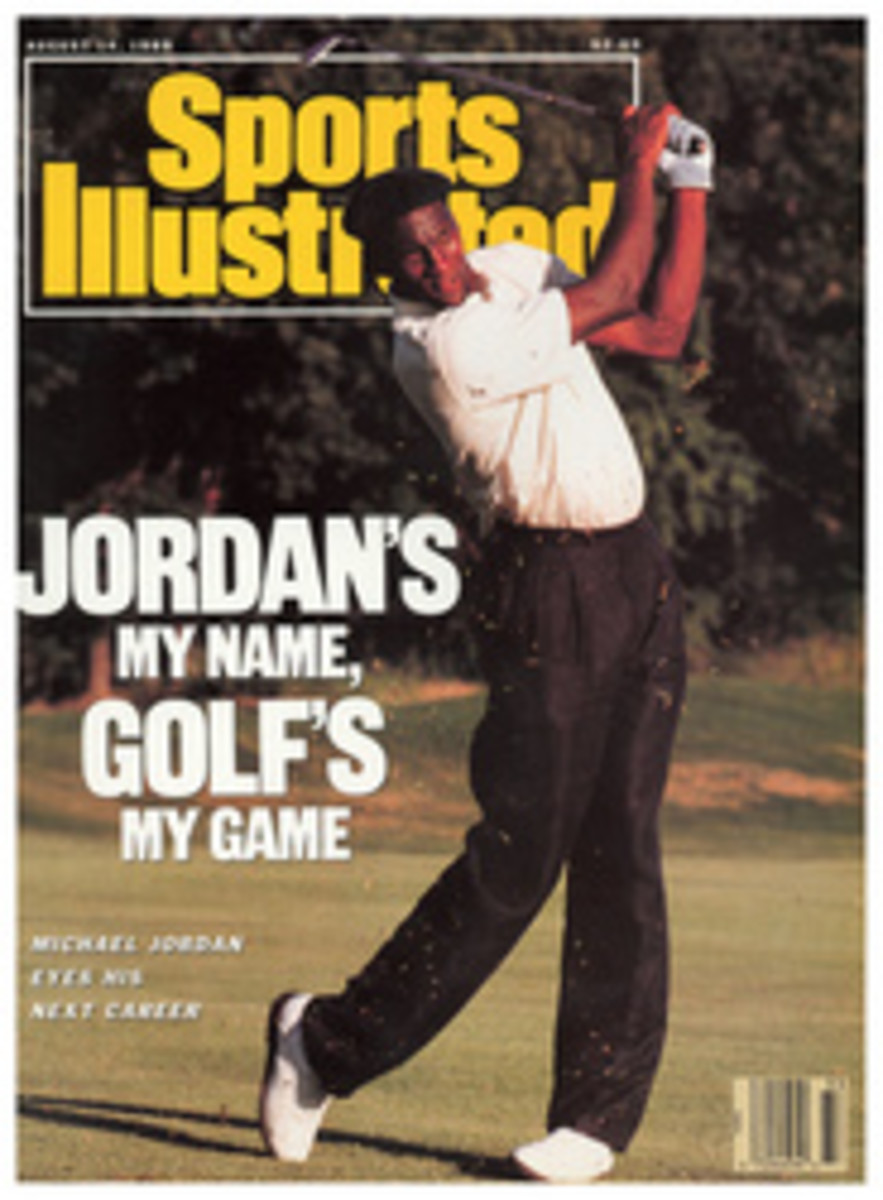
A LEISURELY GAME WITH SOME WICKET ACTION
Steve Jones, a chemical engineer from New Zealand, is doing what appears from a distance to be fingertip push-ups in the middle of a lawn. The tip of his nose is inches from the closely mowed grass. A shapeless white hat shades his face. He is sighting along an imaginary line, propped on his hands and on one foot, keeping grass stains off his immaculate white shirt and shorts. His other foot waves in the air.
He is on the verge of victory in a tournament that has lasted for five days. It is a game of bizarre rules, complex strategies and arcane terminology played against a ticking stopwatch. It is a game for compulsive perfectionists, one in which a single mistake by an opponent can give a player a rush of sadistic joy. In five days of play, Jones has not lost a game.
Jones is sighting down the line formed by two heavy, composition cork balls and a wooden stake. He is playing croquet, and he is two strokes away from the world championship. Beneath the blue sky of northern California, the courts are still. There is no wind to relieve the intense heat. All that can be heard is the buzzing of yellow jackets. The insects are drawn by the faint odor of chardonnay that wafts from the steel tanks and oaken casks of Sonoma-Cutrer, a tiny winery in Sonoma County, an hour north of San Francisco.
Sonoma-Cutrer is celebrated for its superb chardonnay, its striking architecture and its croquet lawns, which may be the best in the world. For four days the pristine playing fields have been off-limits to all but a motley crew of Brits and colonials—Americans, Australians, New Zealanders, Canadians, Irish—18 of the top players in the world. All of them are male, though women have played in the tournament in past years.
All wear white; most are bare-kneed and sunburned. And they clutch elegant, hand-turned wooden mallets. None of the players is remotely aristocratic. They are plumbers, machinists, engineers, builders and schoolteachers, and they look a little like polo players from some not-very-exclusive club in the outback. Now, on Saturday afternoon, all but two have been eliminated from play.
The court is surrounded by spectators, most dressed in white. The women wear ankle-length skirts and wide-brimmed hats. Young men out of Fitzgerald novels lounge along the stone walls that line the lawns, dressed in seersucker suits and panama hats, or white slacks and Ralph Lauren sweaters. The image of croquet in the U.S. may be that of Newport, the Hamptons and Palm Beach, the old enclaves of the idle rich, but the game is growing in popularity among young sunbelt exurbanites from Georgia to Arizona and northern California. At this tournament, though, most of the spectators are wine lovers who are there for a charity event.
Damon Bidencope is slumped in a chair under a blue-and-white-striped canopy on the edge of the court, watching as Jones sights in his final shots. A handsome curly-haired young Australian, Bidencope is the croquet pro at Meadowood, a resort in the "other valley," as Napa is referred to here. For five days he has played with almost inhuman perfection. But in croquet, such perfection isn't always enough.
Serious croquet bears little resemblance to the garden-variety game. The intricate rules make it necessary for players to plan their strategies a dozen moves in advance. To be successful, one needs a billiard-player's eye for angles and positions as well as the steady wrists of a professional golfer on the final green. (Many of the top croquet players also play golf, squash, snooker or billiards. For example, Tony Stephens, who is a New Zealand dairy farmer, is also a highly rated billiards player and was once a nationally ranked pole vaulter and decathlete.)
Each player maneuvers a pair of croquet balls—red-and-yellow versus blue-and-black—around a 105- by 84-foot lawn. The balls are played through a set of six hoops or wickets—clockwise and back again counterclockwise—before they are finally "pegged out" against a single stake in the center of the lawn. You get to keep hitting by going through the wickets in correct order, or by knocking your ball against any of the other three balls on the lawn. The winner is the player who pegs out first or who scores the most points within an assigned time limit. These matches are being played against a two-hour clock. One point is earned for clearing each of the wickets and hitting the stake. The maximum score is 26.
Because each player uses two balls, the game is much more complex than the backyard variety. (Nor are contestants allowed to place their foot on an opponent's ball in order to send it skidding across the green, as in picnic croquet.) Defense is particularly critical. It's important to score points, but it's also important to stick your opponent with a difficult "leave"—the location of his balls relative to yours—when his turn comes. The trick is not only to advance each of your balls but also to maneuver those of your opponent into a disadvantageous spot. Against an elegant "leave," a shooter may find himself having only a single shot at the other player's ball 60 or more feet away. Like Minnesota Fats shooting pool, the good players don't leave much when they miss. But then, the best players can send a ball crashing into a rival's ball from one end of the lawn to the other.
There is also the possibility of committing fouls in tournament play. For instance, having a ball strike the sides of a wicket while the ball is still in contact with the mallet is a foul, causing the turn to end and the balls to be returned to their previous position. Difficult shots, where a foul might be committed, are taken directly under the eye of the referee. At the worlds, that's Jean Corry, 69, a small gray-haired woman who has been refereeing croquet matches for 33 years. She was flown in from New Zealand to judge the tournament. The wickets offer only [1/16] of an inch clearance on either side of the ball. "Sell you a tube of Vaseline for a quarter" is the wicket-setter's jaunty shout to the players as he comes in from the green before the match.
There is no prize money awarded in the Sonoma-Cutrer final; the winner receives a crystal trophy. There is no professional croquet circuit, but a few major tournaments have begun paying cash prizes. Sonoma-Cutrer came up with its world championship four years ago simply by persuading sponsors to put up the money to fly in the top players.
In the whispered commentary overheard along the sidelines, the talk among the game's experts is of croquets and roquets, cut rushes and pass rolls, jump shots and hammer shots, lifts and leaves, triple peels, penultimates and rovers. On the lawns, the games take place in almost total silence. Occasionally, a muted cry—"Oh, bloody pathetic!"—can be heard across the grass.
Steve Mulliner, an Englishman who has dominated croquet for the last three years, is out with a broken leg (not a croquet injury), leaving the '89 championship wide open. The early betting favorite among the players was Neil Spooner of Australia, the winery's own pro, and one of the top-ranked players in the world. But Spooner blew up on Day 4 when he failed to pull off a shot that might have crippled his opponent, and ruined his own chances instead.
Ted Prentis of the U.S., the heavyset croquet pro for the Palm Beach Polo and Country Club, had traversed the courts like a tank. But late Friday afternoon he lost a mistake-ridden game to Simon Williams, a young professional bassoon player from Ireland who talks to himself while taking shots, and who barely stops to line them up.
Earlier Saturday morning, Williams had played what he tersely described as a "one-mistake match" against Mark Avery of England, a tall, 23-year-old who works for his father's construction company and who is one of the top players in the world. Williams's one mistake proved fatal. But within the hour Avery, too, was being beaten by the even more ruthless accuracy of Bidencope. That set up the afternoon final.
At noon, there is a break in the proceedings. At tables with white umbrellas, the white-clad players and spectators pause to enjoy a lunch of cold rack of lamb with pesto, asparagus and strawberries—accompanied, of course, by the winery's chardonnay.
Thus refreshed, all turn their attention to the final match. Jones does well in the early going, but Bidencope comes back brilliantly with a couple of long and tricky runs and builds up a large lead. But the Australian finally falters, failing to clear a crucial wicket with his red ball. Jones pauses briefly to survey his position, coolly asks the timekeeper how much time remains—49 minutes—and sets about the task at hand.
Half an hour later Jones is in the push-up position, lining up his final shots. His glasses and his wispy mustache are almost hidden under his floppy hat, and his socks droop around his ankles. Rising to his feet, the New Zealander finishes off the Australian with two quick strokes. The winner removes his hat and stands blinking in the bright sun, modestly accepting the warm applause of the spectators—few of whom actually grasp the strategic intricacies of the game they have just seen played out before them on the lawn.
PHOTO
CINDY CHARLES
Jones got down—but not dirty—as he assayed a shot during the final of the croquet world championship.
PHOTO
CINDY CHARLES
Corry came all the way from New Zealand to referee the worlds.
Michael Brody is a free-lance writer who lives in Healdsburg, Calif.

